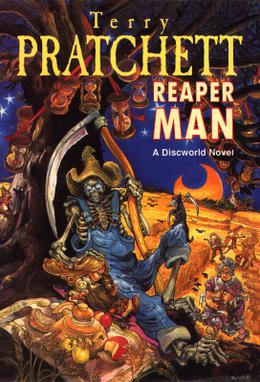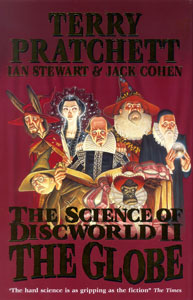
Ronald William "Josh" Kirby was a British commercial artist. Over a career spanning 60 years, he was the artist for the covers of many science fiction books including Terry Pratchett's Discworld novels.

Sir Terence David John Pratchett was an English humorist, satirist, and author of fantasy novels, especially comical works. He is best known for his Discworld series of 41 novels.

Sourcery is a fantasy novel by British writer Terry Pratchett, the fifth book in his Discworld series, published in 1988.

The Colour of Magic is a 1983 fantasy comedy novel by Terry Pratchett, and is the first book of the Discworld series. The first printing of the British edition consisted of only 506 copies. Pratchett has described it as "an attempt to do for the classical fantasy universe what Blazing Saddles did for Westerns."

The Light Fantastic is a comic fantasy novel by Terry Pratchett, the second of the Discworld series. It was published on 2 June 1986, the first printing being of 1,034 copies. The title is taken from L'Allegro, a poem by John Milton, and refers to dancing lightly with extravagance.

Ian Nicholas Stewart is a British mathematician and a popular-science and science-fiction writer. He is Emeritus Professor of Mathematics at the University of Warwick, England.

Rincewind is a fictional character appearing in several of the Discworld novels by Terry Pratchett. He is a failed student at the Unseen University for wizards in Ankh-Morpork, and is often described by scholars as "the magical equivalent to the number zero". He spends most of his time running away from bands of people who want to kill him for various reasons. The fact that he's still alive and running is explained in that, although he was born with a wizard's spirit, he has the body of a long-distance sprinter. Rincewind is also renowned for being able to solve minor problems by turning them into major disasters. His unique "skill" is implied to be due to being the chosen one of "The Lady", the anthropomorphic personification of luck.
Jack Cohen, FRSB was a British reproductive biologist also known for his science books and involvement with science fiction.
A lie-to-children is a simplified, but false, explanation of technical or complex subjects as a teaching method for children and laypeople. The technique has been incorporated by academics within the fields of biology, evolution, bioinformatics and the social sciences. It is closely related to the philosophical concept known as Wittgenstein's ladder.

Reaper Man is a fantasy novel by British writer Terry Pratchett. Published in 1991, it is the 11th Discworld novel and the second to focus on Death. The title is a reference to Alex Cox's movie Repo Man.

Thief of Time is a fantasy novel by British writer Terry Pratchett, the 26th book in his Discworld series. It was the last Discworld novel with a cover by Josh Kirby.

The Science of Discworld II: The Globe is a 2002 book written by British novelist Terry Pratchett and science writers Ian Stewart and Jack Cohen. It is a sequel to The Science of Discworld, and is followed by The Science of Discworld III: Darwin's Watch.

The Science of Discworld is a 1999 book by novelist Terry Pratchett and popular science writers Ian Stewart and Jack Cohen. Three sequels, The Science of Discworld II: The Globe, The Science of Discworld III: Darwin's Watch, and The Science of Discworld IV: Judgement Day, have been written by the same authors.

The Discworld Companion is an encyclopaedia of the Discworld fictional universe, created by Terry Pratchett and Stephen Briggs. Four editions have been published, under varying titles.

Terry Pratchett's Hogfather is a 2006 two-part British Christmas-themed fantasy comedy television miniseries adaptation of Hogfather by Terry Pratchett, produced by The Mob, and first broadcast on Sky1, and in High Definition on Sky1 HD, over Christmas 2006. First aired in two 1.5-hour episodes on 17 and 18 December 2006 at 20:00 UTC, it was the first live-action film adaptation of a Discworld novel. In 2007, the two episodes were rerun on Christmas Eve and Christmas Day respectively on Sky One and Sky1 HD.

Terry Pratchett's The Colour of Magic is a fantasy-comedy two-part British television adaptation of the bestselling novels The Colour of Magic (1983) and The Light Fantastic (1986) by Terry Pratchett. The fantasy film was produced for Sky1 by The Mob, a small British studio, starring David Jason, Sean Astin, Tim Curry, and Christopher Lee as the voice of Death. Vadim Jean both adapted the screenplay from Pratchett's original novels, and served as director.

Discworld is a comic fantasy book series written by the English author Terry Pratchett, set on the Discworld, a flat planet balanced on the backs of four elephants which in turn stand on the back of a giant turtle. The series began in 1983 with The Colour of Magic and continued until the final novel The Shepherd's Crown, which was published in 2015, following Pratchett's death. The books frequently parody or take inspiration from classic works, usually fantasy or science fiction, as well as mythology, folklore and fairy tales, and often use them for satirical parallels with cultural, political and scientific issues.
The North American Discworld Convention is a fan-run science fiction convention to celebrate the works of Sir Terry Pratchett, focusing primarily on his long-running series of Discworld novels. It is held biennially on odd-numbered years to accommodate the UK Discworld Convention, which is on even-numbered years. The first NADWCon was held in 2009 and sponsored by Arizona-based LepreCon, Inc. The 2019 convention is to be held July 12th-15th, at the Westin LAX.

The Science of Discworld IV: Judgement Day is a book set on the Discworld, by Terry Pratchett, Ian Stewart and Jack Cohen. It is the sequel to The Science of Discworld, The Science of Discworld II: The Globe and The Science of Discworld III: Darwin's Watch.
The Long Earth is a collaborative science fiction novel series by British authors Terry Pratchett and Stephen Baxter.















